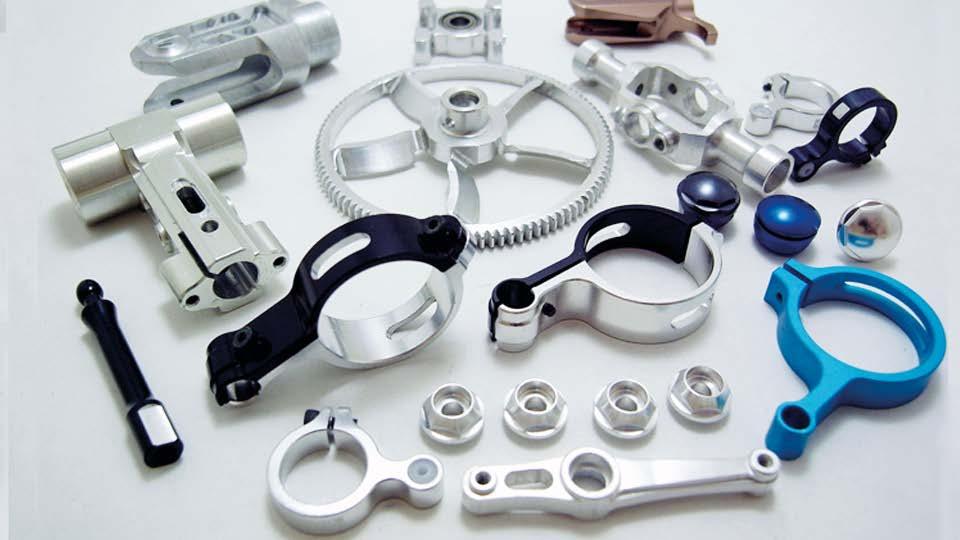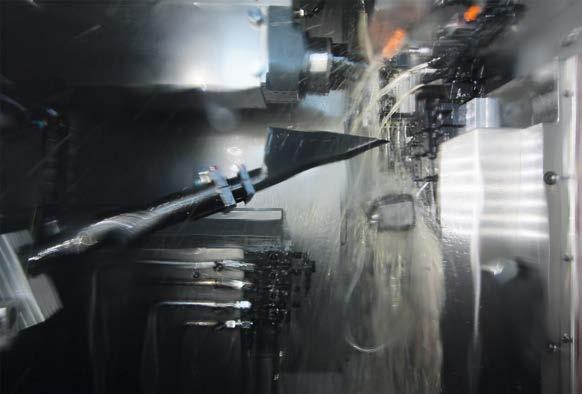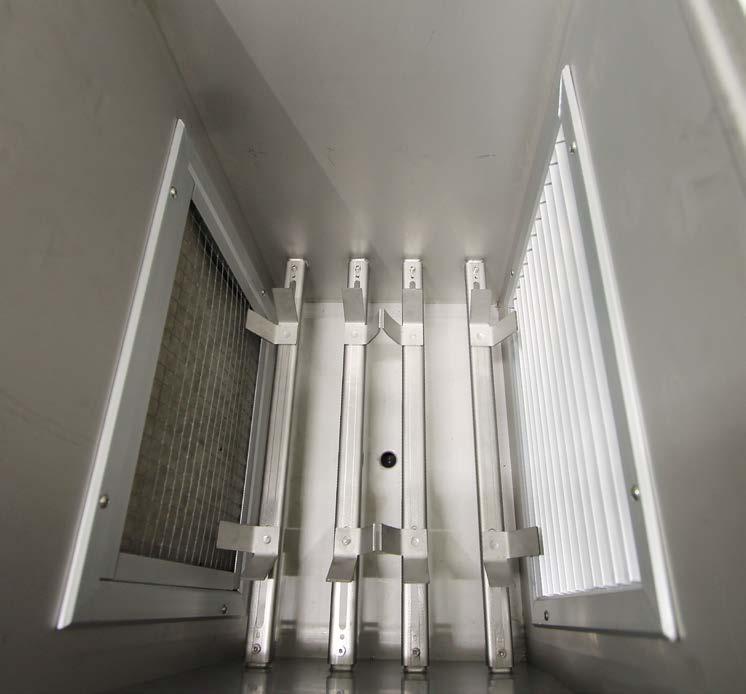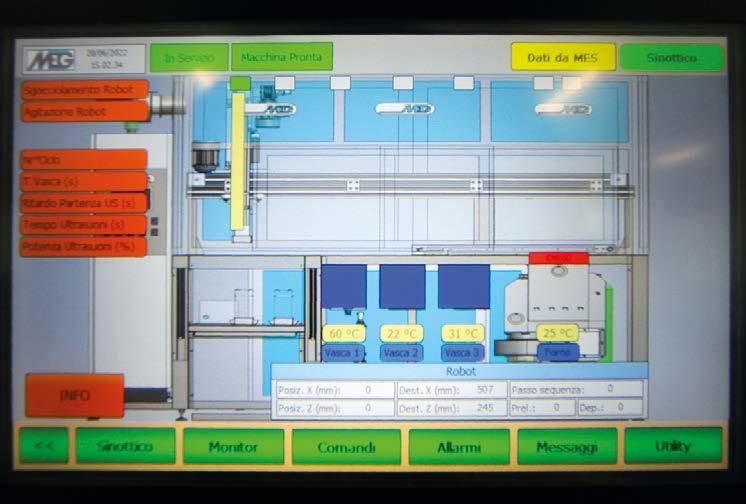
10 minute read
INDUSTRY NEWS - ICT
OMSG’s rotary table shot blasting machine installed at ARCOPROFIL’s premises
Arcoprofil (Schio, Vicenza, Italy), a company specialising in the production of splined shafts for the automotive and agricultural sectors and featured in an article in the last issue of ICT Industrial Cleaning Technologies (no. 21, April 2022, pp. 20-27), has installed a new shot blasting machine designed and manufactured by OMSG (Villa Cortese, Milan, Italy) to remove any calamine and other residues after case hardening and oil hardening.
Below are the main features of the rotary table shot blasting plant: • Type: RT 200 1E-11 • Table diameter: ø 2000 mm • 2 patented OMSG turbines of 11 kW each, with direct drive • Inverter regulating turbine speed • Inverter regulating table rotation speed • Special turbine feed valve with 2 pneumatic cylinders • Automatic table orientation device. The OMSG machine, prearranged for Industry 4.0-oriented integrations, mechanically cleans Arcoprofil’s parts after the two thermal processes of induction hardening through quench cooling and case hardening with oil hardening. In our previous article, the rotary table shot blasting plant installed by Arcoprofil was not correctly attributed to OMSG. We apologise to readers and all those concerned.
For further information: www.omsg.it
© ipcm
EnSolv® CC-A vapour degreasing solvent for precision parts cleaning
The EnSolv® CC-A methylene chloride based formulation responds to the need for high performance vapour degreasing solvents for critical cleaning in general engineering, aerospace, medical optical and electrical industries.
EnSolv® CC-A removes cutting oils, lubricants, lapping compounds grinding pastes and water based cutting oils or fluids. This complex synergistic blend utilises environmentally compliant solvents combined with selected surfactants to remove oils and lubricants to the highest standards for critical cleaning applications and releases and suspends inorganic solids and soils such as fingerprints, polishing compounds and grinding paste from finely finished and highly polished surfaces such as stainless steel and plated parts, optical lenses and components for medical appliances.
Improves productivity and operating environment
• Suitable for processing temperature sensitive components as well as the conventional engineering substrates: the very low surface tension cleans through holes on castings and penetrates between overlapping metal spot welds eliminating oil leaching in paint and powder coatings during oven curing. • Easy handling: cleaned components are dry and comfortable to handle immediately at the ideal temperature for painting or powder coating. No time lost waiting for parts to cool which allows immediate quality control testing or assembly of machined parts due to minimal dimensional changes. • Cleaning cycles reduced: productivity improved with output doubled compared to conventional solvents. • Minimises flash rusting on mild steel cleaned components due to the advanced stabiliser/inhibitor package compared to alternative formulations. Compatible with mixed metal components. No staining of yellow metals, bronze, copper, aluminium. • Reduced maintenance: unique additive suspends contaminants in boiling solvent sump preventing tar formation and continuously cleans heating surfaces. Longer periods between cleanouts reduces labour costs and solvent losses.
For further information: www.envirotech-europe.com
© Envirotech

Excellent cleanliness, high production speed, and digital integration: Advan’s watchwords for its new dental implant cleaning process
The surface decontamination of dental implants and prosthetic components is a strategic operation in the production cycle of Advan, which has recently turned into a factory 4.0 by equipping itself with the most modern technologies available on the market for the cleaning and surface treatment of its titanium plants. Thanks to its MEG machines, in particular, it has speeded up its cleaning process by reducing cycle times by a third, improved the cleanliness of components, and optimised business management by integrating cleaning control software into its MES system.
© Advan
A dental implant produced by Advan. Dental implants are medical devices used to replace teeth roots, provide support for removable or fixed dentures, and help improve chewing function and aesthetics, thus ultimately improving people’s quality of life. Implantology is a branch of dentistry characterised by very delicate titanium components that, in order to fully perform their functions, must meet strict quality criteria in terms of both process validation and of the high surface cleanliness requirements imposed on finished products. Established in 2018 from the merger of two other companies with over twenty-five years of experience in the design, manufacture, and sale of implant dentistry products, Advan Srl (Amaro, Udine, Italy) has long pursued an innovative corporate vision: placing implants at the centre of a digital flow as an essential tool made available to dentists to better meet their patients’ demands. “Conceiving and implementing easy-to-manage implant systems with high clinical performance degrees and highly predictable long-term results, including through digital adaptation of devices, is one of Advan’s main goals,” explains Danilo Annesi, the technical and R&D manager of the company. “All our employees are well aware that our products’ quality affects the quality of life of thousands of people every day. With a view to updating and improving our logistics and production processes, in 2022 we built a new factory where we relocated all our departments. In particular, since cleaning is a key production step in the field of implant dentistry, one of the focus items for the new factory project involved upgrading this process by replacing our old machines with two new systems capable of meeting our requirements of high surface cleanliness, high speed of operation, and integration into our MES system. With the collaboration of MEG Srl (San Martino di Lupari, Padua, Italy), specialising in the design and production of cleaning systems, we have equipped ourselves with the right tools to achieve these goals.”
Advan constantly reinvents implant dentistry
“In our company,” says Annesi, “experience is combined with constant and meticulous attention to material developments, innovations, new production technologies, and clinical guidelines in our field together with the most current scientific contributions. We experiment with everything we
© ipcm © ipcm

© ipcm

The first dental implant machining stage, with state-of-the-art sliding-head lathes and the HFE solvent system for the preliminary cleaning phase. The inside of the multi-function cleaning chamber.

consider valid for the continuous development of our dental implants, which include conical connection implants, zygomatic implants with internal connections, prosthetic components with conical connections and couplings, and surgical and prosthetic instruments. In fact, at the beginning of the 2000s, we pioneered in Europe the use of a surface treatment for implant screws that was already employed in the United States, but still unknown overseas, called OsseoGRIP: it is a microsandblasting process carried out using hydroxyapatite to improve the osteoconductivity of titanium oxide. Compared with other common abrasive materials such as alumina or corundum, this guarantees high implant durability even if any micro-residues remain on surfaces, because of its high compatibility.”
The strategic nature of the cleaning phase
Annesi illustrates Advan’s production flow: “After receiving our required titanium alloy bars, we perform precision turning operations with advanced CNC machine tools to produce parts with diameters ranging from 2 to 6 mm and lengths from 4 to 60 mm. The cleaning, surface treatment, and assembly processes are carried out on the resulting semi-finished products in a manufacturing area equipped with an ISO Class 8 controlled-contamination room, whereas decontamination and packaging occur in our ISO Class 7 clean room.” Surface cleaning and decontamination are the treatments in which Advan has invested the most resources. “Previously, our cleaning process was completely manual and it was carried out with ultrasound
© ipcm
© ipcm The drying station.

The touch-screen control of the multi-tank system. machines using alcohol and an oven for drying. The same systems were used for both the preliminary and final cleaning phases. In addition to the need to increase productivity by speeding up our cleaning operations, we sought an automated solution to reduce the risk of part contamination due to operator handling. This is why we implemented a solvent system for the post-turning preliminary cleaning phase and an automated system for the final cleaning phase, which were integrated into our production flow in line with the Industry 4.0 parameters. Provided by MEG, these two plants have optimised our cleaning cycle and led to a 300% increase in productivity.”

The preliminary cleaning phase
“One of the main causes of contamination of Advan’s products,” states MEG general manager, Alberto Gnoato, “is the presence of microburrs remaining inside their threaded holes after machining, together with neat oil traces. In particular, these residues are found on the surfaces of one of their flagship products, that is, their implants with conical connections, which consist of an external thread, the actual connection, and a 1.6 mm internal thread. Together with the Advan team, we therefore selected an extremely compact, yet highly performing machine for HFE solvent cleaning operations. The cycle includes four stages: vapour degreasing, immersion cleaning with ultrasound, rinsing, and drying by condensation of the solvent, which is recovered and recirculated to the system thanks to a molecular sieve separator.” After this preliminary cleaning phase, the implant screws undergo precise and accurate checks with optical measuring microscopes and laser scanners for dimensional measurements. They are then subjected to rotating disc sandblasting with hydroxyapatite and passivation in citric acid in the controlled-contamination room to remove any surface residues remaining after sandblasting. After they are sent to the clean room though a pass box, the decontamination phase with cold argon plasma is performed, followed by blister packing and heat sealing.
The final cleaning phase
“The second plant installed by MEG is a fully automated water and detergent system,” indicates Gnoato. “It is used for cleaning prosthetic components after dimensional inspection and it is equipped with three heated tanks with a capacity of 8 litres each: one for treatment with mains water and detergent (which is automatically dosed by a special dispenser), one for rinsing with mains water, and the third for rinsing with demineralised water in a closed loop. Drying then occurs in an integrated two-slot ventilated oven.” The average cleaning cycle time has been significantly reduced, as Annesi confirms: “We went from a cleaning and drying time of 25 minutes to one of 8 minutes. This was a fundamental achievement with a view to the goal of higher production speed we had set ourselves.”

© ipcm
The prosthetic component cleaning machine.

© ipcm

The loading/unloading station of the prosthetic component cleaning plant.
© ipcm

The pass box for transferring cleaned components to the clean room. Structural separation of tanks is one of the main features of MEG machines. “The ultrasonic tanks in our systems,” explains Gnoato, “are not welded directly to the machine structure, but separated from it by special silent blocks that limit the vibrations of the machine body itself, thus guaranteeing longer service life and reduced noise emissions. Moreover, in this way, if the tank needs to be replaced, the intervention is quick and easy. The same applies to ultrasonic flanges, applied through counter flanges that allow for easy removal should the need arise.”
Conclusions
“A further aspect that convinced us to start a partnership with MEG,” emphasises Annesi, “was the ability of its IT team to update and adapt its control software package to manage cleaning processes not only on board the machines but also through our company’s central system. Thanks to such integrated management, we are currently also implementing a batch tracking system with barcodes. “The commissioning of the two cleaning plants is recent – the water and detergent system was installed in December 2021 and the solvent one in February 2022 – and there are still some aspects to be improved for optimising our programmes. However, the fact that we have reduced cycle times by a third is already proof that we chose the right technology and the right partner. We were looking for a plant solution that was not oversized for our needs and MEG’s machines proved to be perfectly adequate. Already during the tests we carried out at their laboratory in Padua, we had assessed the effectiveness of their cleaning systems, which was confirmed by the validation of the resulting new process: we went from a CFU (Colony-Forming Unit) value of 3-4 to one of 0-1. Considering that the limit allowed by specifications is 1000 CFU, we have reached the optimum.”











